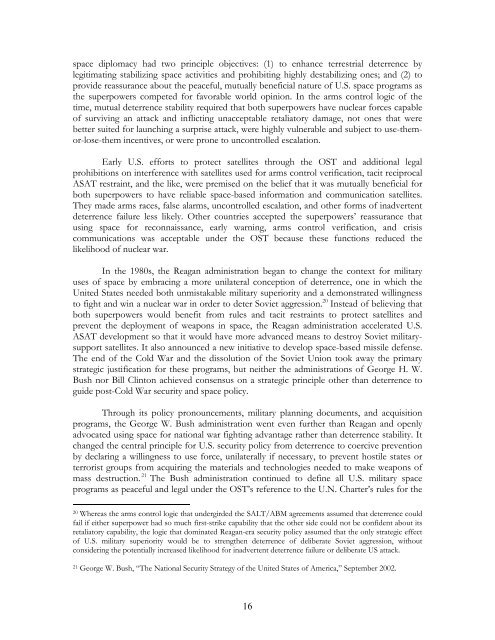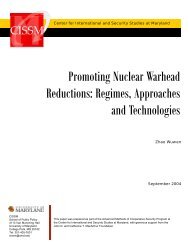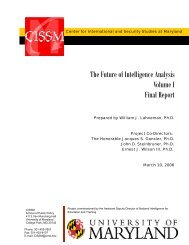A Reassurance-Based Approach to Space Security - Center for ...
A Reassurance-Based Approach to Space Security - Center for ...
A Reassurance-Based Approach to Space Security - Center for ...
- No tags were found...
Create successful ePaper yourself
Turn your PDF publications into a flip-book with our unique Google optimized e-Paper software.
space diplomacy had two principle objectives: (1) <strong>to</strong> enhance terrestrial deterrence bylegitimating stabilizing space activities and prohibiting highly destabilizing ones; and (2) <strong>to</strong>provide reassurance about the peaceful, mutually beneficial nature of U.S. space programs asthe superpowers competed <strong>for</strong> favorable world opinion. In the arms control logic of thetime, mutual deterrence stability required that both superpowers have nuclear <strong>for</strong>ces capableof surviving an attack and inflicting unacceptable retalia<strong>to</strong>ry damage, not ones that werebetter suited <strong>for</strong> launching a surprise attack, were highly vulnerable and subject <strong>to</strong> use-themor-lose-themincentives, or were prone <strong>to</strong> uncontrolled escalation.Early U.S. ef<strong>for</strong>ts <strong>to</strong> protect satellites through the OST and additional legalprohibitions on interference with satellites used <strong>for</strong> arms control verification, tacit reciprocalASAT restraint, and the like, were premised on the belief that it was mutually beneficial <strong>for</strong>both superpowers <strong>to</strong> have reliable space-based in<strong>for</strong>mation and communication satellites.They made arms races, false alarms, uncontrolled escalation, and other <strong>for</strong>ms of inadvertentdeterrence failure less likely. Other countries accepted the superpowers’ reassurance thatusing space <strong>for</strong> reconnaissance, early warning, arms control verification, and crisiscommunications was acceptable under the OST because these functions reduced thelikelihood of nuclear war.In the 1980s, the Reagan administration began <strong>to</strong> change the context <strong>for</strong> militaryuses of space by embracing a more unilateral conception of deterrence, one in which theUnited States needed both unmistakable military superiority and a demonstrated willingness<strong>to</strong> fight and win a nuclear war in order <strong>to</strong> deter Soviet aggression. 20 Instead of believing thatboth superpowers would benefit from rules and tacit restraints <strong>to</strong> protect satellites andprevent the deployment of weapons in space, the Reagan administration accelerated U.S.ASAT development so that it would have more advanced means <strong>to</strong> destroy Soviet militarysupportsatellites. It also announced a new initiative <strong>to</strong> develop space-based missile defense.The end of the Cold War and the dissolution of the Soviet Union <strong>to</strong>ok away the primarystrategic justification <strong>for</strong> these programs, but neither the administrations of George H. W.Bush nor Bill Clin<strong>to</strong>n achieved consensus on a strategic principle other than deterrence <strong>to</strong>guide post-Cold War security and space policy.Through its policy pronouncements, military planning documents, and acquisitionprograms, the George W. Bush administration went even further than Reagan and openlyadvocated using space <strong>for</strong> national war fighting advantage rather than deterrence stability. Itchanged the central principle <strong>for</strong> U.S. security policy from deterrence <strong>to</strong> coercive preventionby declaring a willingness <strong>to</strong> use <strong>for</strong>ce, unilaterally if necessary, <strong>to</strong> prevent hostile states orterrorist groups from acquiring the materials and technologies needed <strong>to</strong> make weapons ofmass destruction. 21 The Bush administration continued <strong>to</strong> define all U.S. military spaceprograms as peaceful and legal under the OST’s reference <strong>to</strong> the U.N. Charter’s rules <strong>for</strong> the20 Whereas the arms control logic that undergirded the SALT/ABM agreements assumed that deterrence couldfail if either superpower had so much first-strike capability that the other side could not be confident about itsretalia<strong>to</strong>ry capability, the logic that dominated Reagan-era security policy assumed that the only strategic effec<strong>to</strong>f U.S. military superiority would be <strong>to</strong> strengthen deterrence of deliberate Soviet aggression, withoutconsidering the potentially increased likelihood <strong>for</strong> inadvertent deterrence failure or deliberate US attack.21 George W. Bush, “The National <strong>Security</strong> Strategy of the United States of America,” September 2002.16







